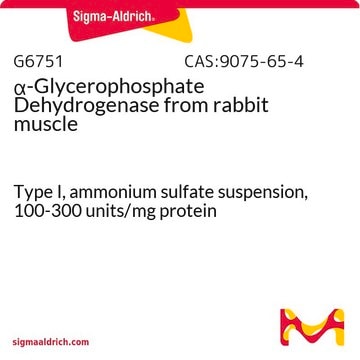39705
D-Glyceraldehyde 3-phosphate solution
8-13 mg/mL in H2O
Synonym(s):
(2R)-2-Hydroxy-3-phosphonooxypropanal, D-GAP, Triose phosphate
Sign Into View Organizational & Contract Pricing
All Photos(1)
About This Item
Empirical Formula (Hill Notation):
C3H7O6P
CAS Number:
Molecular Weight:
170.06
Beilstein:
1725007
MDL number:
UNSPSC Code:
12352201
PubChem Substance ID:
NACRES:
NA.25
Recommended Products
Assay
≥97.0% (TLC)
form
solution
concentration
8-13 mg/mL in H2O
color
colorless
storage temp.
−20°C
SMILES string
O[C@H](COP(O)(O)=O)C=O
InChI
1S/C3H7O6P/c4-1-3(5)2-9-10(6,7)8/h1,3,5H,2H2,(H2,6,7,8)/t3-/m0/s1
InChI key
LXJXRIRHZLFYRP-VKHMYHEASA-N
Related Categories
Application
- Enzymatic Assay Development with d-Glyceraldehyde 3-Phosphate: Demonstrated as a crucial reagent in enzymatic assays involving glycolysis pathways, specifically in the assessment of glyceraldehyde 3-phosphate dehydrogenase activities, which play a vital role in understanding cellular energy production and metabolic disorders (Li et al., 2022).
Biochem/physiol Actions
An important substance implicated in energy metabolism. It is a key node point linking other metabolic processes or pathways. Triosephosphate metabolism can be associated with many metabolic pathways, including glycolysis, pentose phosphate pathway, gluconeogenesis and lipid metabolism, and can also be involved in maintaining hemostasis. The metabolic abnormality of triosephosphate may be tied to many pathophysiological processes, such as triosephosphate isomerase deficiency, hyperglycemia and diabetic nephropathy; review and papers cited therein.
Other Notes
To gain a comprehensive understanding of our extensive range of Monosaccharides for your research, we encourage you to visit our Carbohydrates Category page.
Storage Class Code
10 - Combustible liquids
WGK
WGK 1
Flash Point(F)
Not applicable
Flash Point(C)
Not applicable
Certificates of Analysis (COA)
Search for Certificates of Analysis (COA) by entering the products Lot/Batch Number. Lot and Batch Numbers can be found on a product’s label following the words ‘Lot’ or ‘Batch’.
Already Own This Product?
Find documentation for the products that you have recently purchased in the Document Library.
Customers Also Viewed
Marko Prous et al.
ZooKeys, 875, 63-127 (2019-10-04)
Keys to adults and larvae of the genera of West Palaearctic nematine sawflies are presented. Species of some of the smaller genera are keyed, and their taxonomy, distribution, and host plants reviewed, with a geographic focus on north-western Europe, particularly
Seçil Akyıldız Demir et al.
Journal of neuroinflammation, 17(1), 277-277 (2020-09-22)
Tay-Sachs disease (TSD), a type of GM2-gangliosidosis, is a progressive neurodegenerative lysosomal storage disorder caused by mutations in the α subunit of the lysosomal β-hexosaminidase enzyme. This disease is characterized by excessive accumulation of GM2 ganglioside, predominantly in the central
Ruilian Yao et al.
Microbial cell factories, 10, 67-67 (2011-08-13)
Most bacteria can use various compounds as carbon sources. These carbon sources can be either co-metabolized or sequentially metabolized, where the latter phenomenon typically occurs as catabolite repression. From the practical application point of view of utilizing lignocellulose for the
Siripat Ngoennet et al.
Life (Basel, Switzerland), 10(3) (2020-03-19)
The halotolerant cyanobacterium, Halothece sp. PCC 7418, possesses two classes of fructose-1,6-bisphosphate aldolase (FBA): H2846 and H2847. Though class I (CI)-FBA H2846 is thought to be associated with salt tolerance, the regulatory mechanisms, molecular characteristics, and expression profiles between H2846
Rebeca Arroyo Hornero et al.
Communications biology, 3(1), 375-375 (2020-07-16)
Regulatory T cells (Tregs) are critical mediators of immune homeostasis. The co-stimulatory molecule CD27 is a marker of highly suppressive Tregs, although the role of the CD27-CD70 receptor-ligand interaction in Tregs is not clear. Here we show that after prolonged
Our team of scientists has experience in all areas of research including Life Science, Material Science, Chemical Synthesis, Chromatography, Analytical and many others.
Contact Technical Service













